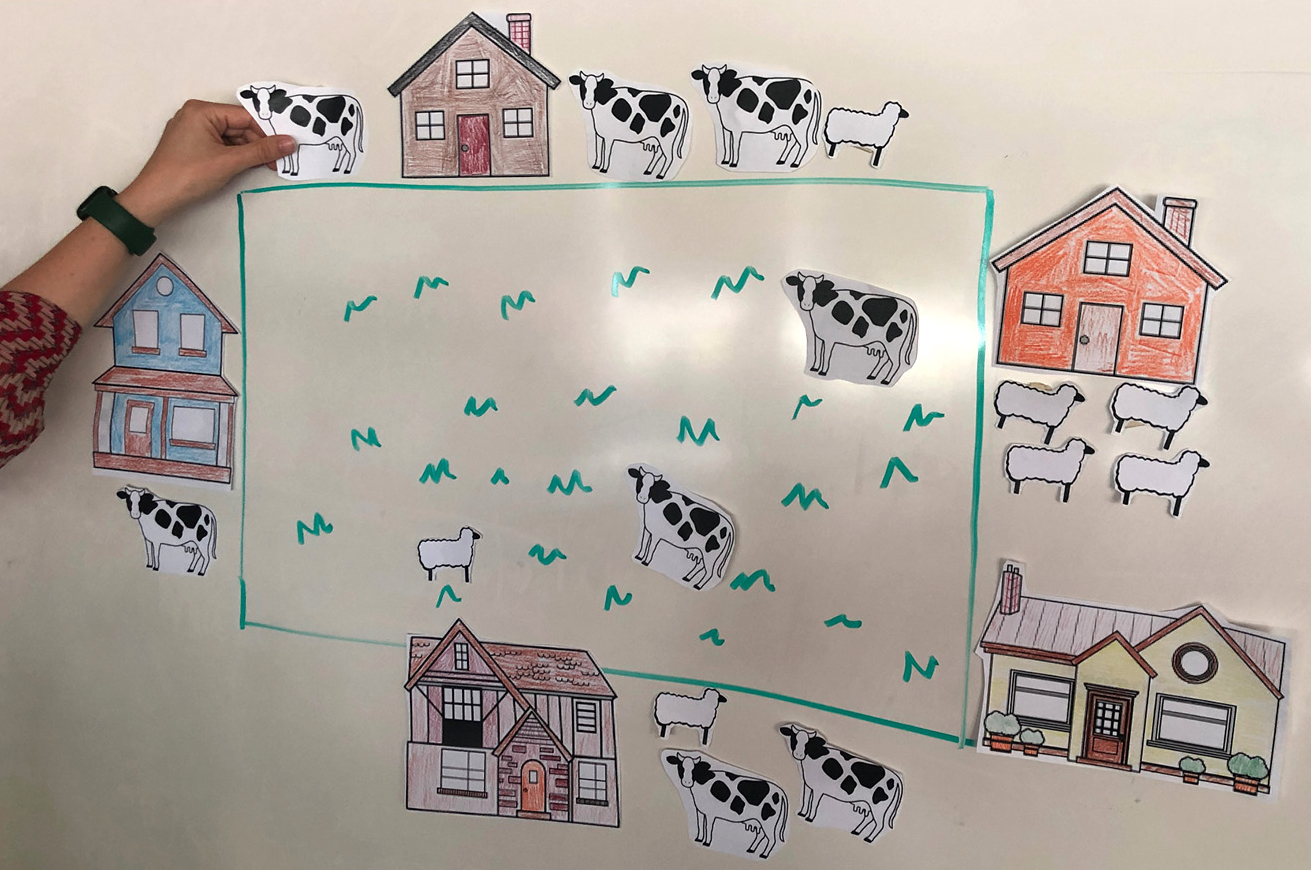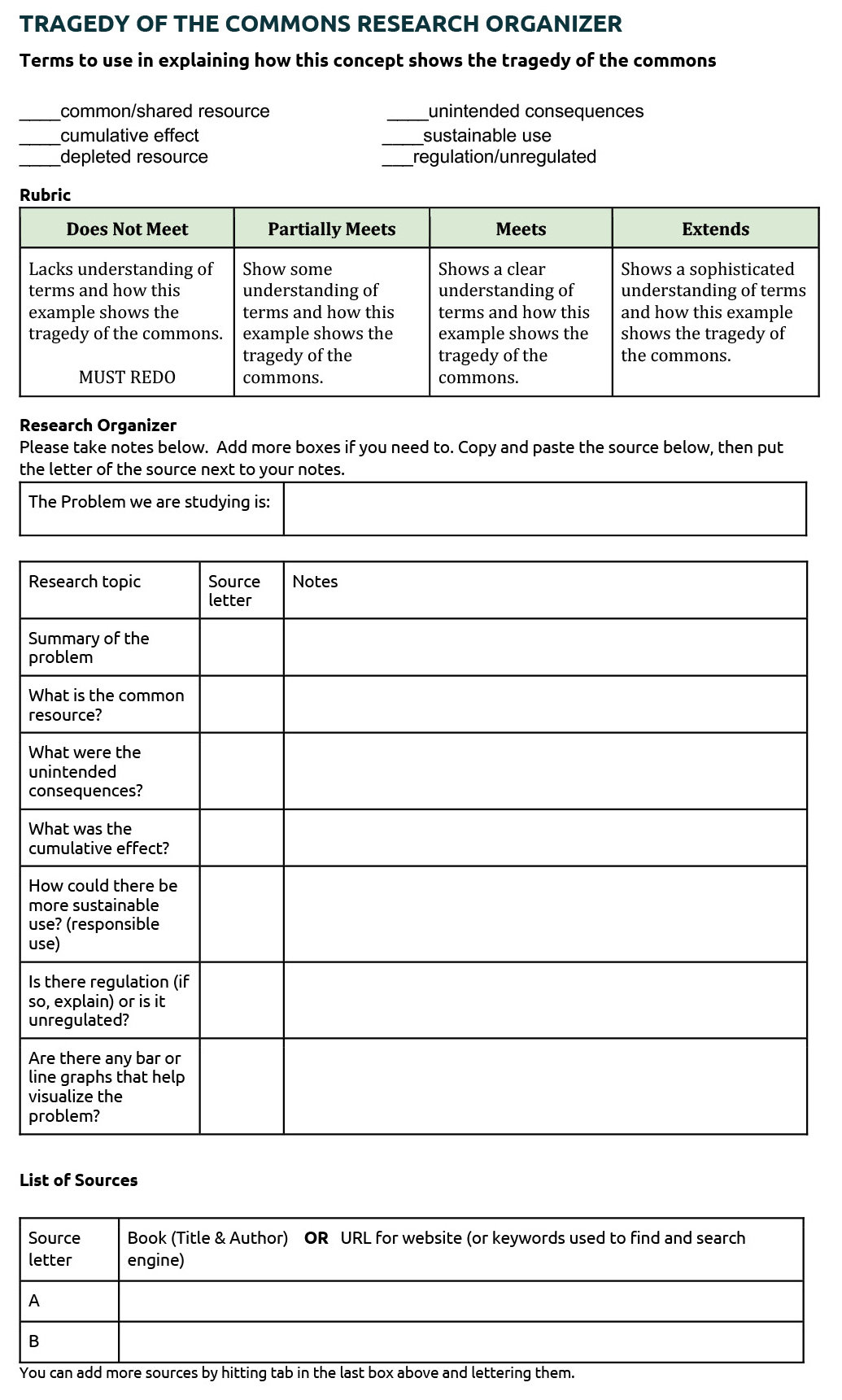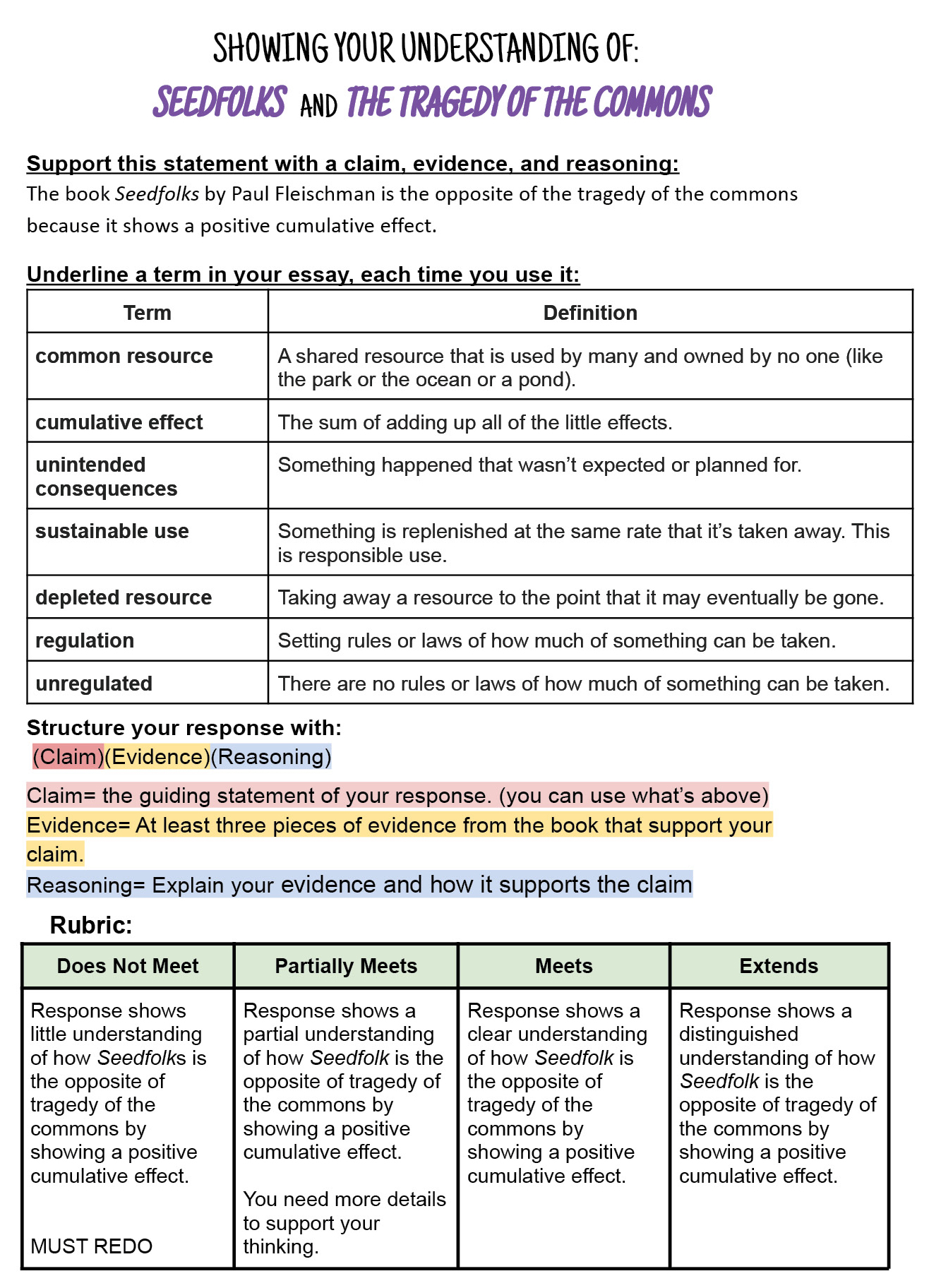interdisciplinary ideas
The Tragedy of the Commons
Science Unit Design With Embedded Literacy
Science Scope—March/April 2023 (Volume 46, Issue 4)
By Katie Coppens
At the start of a unit, students walk into my classroom and immediately notice the scene on the board. I’ve drawn green grass and surrounded it with images of houses, cows, and sheep. I explain that the scene shows a town common, a resource for all, around which homes and businesses were often built. Boston Common, which is America’s oldest public park, is shared as an example. I’ll tell the students I am beginning our unit with a story set in the 1800s at a town common, which shows humans’ impact on an environment.
The room is silent as middle schoolers listen to a story that I narrate with visuals. The story begins with one homeowner letting their cow graze on the town common’s grass, and I move a picture of a cow that has rolled tape behind it to the common’s grass (see Figure 1). I explain that other homeowners witness this, so they do the same for their cows and sheep. I erase more grass as each animal is placed on the common. This continues until there is no grass left. I return the cows to their homes and the scene ends with homes surrounding a barren lot.

The author using storytelling to introduce the tragedy of the commons.
This story is based on the 1833 pamphlet by British economist William Forster Lloyd, which was later described as “the tragedy of the commons” in a well-known essay by ecologist Garrett Hardin (1968). I share the title and ask why they think it’s called “the tragedy of the commons.” A student shares that it’s a tragedy because it was preventable.
I then introduce the term unintended consequences and we discuss how nobody meant for this to happen, but little by little there was a negative cumulative effect, which ultimately impacted individuals and the whole community. We then discuss ideas on how this could have been prevented in small groups, then as a large group. Many students advocate for clear rules or limits being stated, and I introduce them to the term policy. I then explain that the tragedy of the commons works as a model that can be applied to any topic that involves a common resource being depleted by individuals thinking about their personal gain and not the long-term environmental or economic consequences.
The discussion of human impact in the 1800s then shifts to today. I hold up our sixth-grade recess equipment bag, which at this point in the year (March) is only a quarter full. I then ask how this connects to the tragedy of the commons. One student describes a four-square ball rolling away when recess ended that no one retrieved, and another explains frustration when a student purposely kicked a ball into the nearby woods. With their table partners, they discuss possible solutions, such as implementing a sign-out process for recess equipment that might hold students more accountable. We then talk about how policy helps, but that it needs to be enforced (regulated) to be effective. The visual model and recess equipment examples serve as the hook for this three-week unit that highlights various modern-day examples of the tragedy of the commons.
Embedded nonfiction literacy skills
Following the discussion, we watch a Ted-Ed video about the tragedy of the commons with drawings of fisherfolk taking too many fish from a pond (see Supplemental Materials). After relating this example to the earlier ones, I introduce their assignment. Students will apply the concept of the tragedy of the commons to a modern environmental example, from which they will have nine different options to choose between. Spooner’s (2016) article summarizes each of these options: bluefin tuna, passenger pigeons, ocean garbage gyres, Earth’s atmosphere, Gulf of Mexico dead zone, traffic congestion, groundwater in Los Angeles, unregulated logging, and population growth. I take her summaries and put them into a slideshow with an added visual to help introduce the options to the class (see Supplemental Materials). Her list also includes Grand Banks fisheries and cod, but instead of that being a choice, I use cod as my model throughout the stages of the assignment.
Students submit their top choices, and I create groups of two or three to research the topic and present how it demonstrates the tragedy of the commons to the class. I provide a research note-taking organizer that contains the essential vocabulary terms and project rubric (see Figure 2 and Supplemental Materials). I also share a Google doc with links to videos, websites, and graphs for each topic and explain why they were considered reliable sources (see Supplemental Materials). I also encourage students to share any sources they find that can be added to the list.

T-chart note-taking organizer.
There’s voice and choice not only in their chosen topic, but also in how they present the topic to the class, both of which increase student engagement (Thibodeau, Harapnuik, and Cummings 2019). I explain the expectations around their speaking skills and scientific thinking within the presentation and challenge the groups to be creative teachers. I remind them how I introduced the concept with the paper cutouts and then model a different technique by teaching about cods’ depletion by displaying different population graphs over time. These graphs become the visual lens by which I tell cods’ story of overfishing and current regulation.
I challenged the groups to be creative teachers, and they thrived in the role. For example, the group that researched passenger pigeons created a game based on rock, paper, scissors in which each student began as a healthy passenger pigeon and different trauma happened to them if they lost a round, causing them to be injured, then dying, then dead. When dead, they lay on the ground and were out of the game. If they won, they didn’t go to a healthier level; instead, they stayed at the same level and kept playing until only one student remained standing (Martha, the last passenger pigeon). Other groups made visuals models, and some acted out skits.
Embedded fiction literacy skills
After students completed their research and presentation, we watch the 1972 version of The Lorax by Dr. Suess, which is an example of the tragedy of the commons. After the movie, we sit in a circle for a Socratic discussion on how this tragedy could have been prevented. Each student is given a visual to hold during the discussion with the character names from The Lorax, along with the unit’s vocabulary, which helps in their communication of concepts (see Supplemental Materials). I support my English language learners (ELLs) by writing sentence frames on the board as recommended by Hoffman (2013). Some examples include “I agree with ___’s thinking because…” and “I have a different interpretation because….”
The final part of this unit is a positive cumulative effect, which is the opposite of the tragedy of the commons or, as one of my students named it, “the success of the commons.” As a class, we read the book Seedfolks by Paul Fleischman over five classes. This is a fictional story of a community garden in Cleveland, Ohio that’s told from 13 different points of view, which represent a range of ages and ethnic groups. The story is about a fractured community coming together, little by little, through a vacant, trash-filled lot becoming a community garden. It begins with a young girl from Vietnam named Kim planting lima beans, and the story intertwines with personal growth for each character and, as a result, the community garden. We listen to the book on audio so students can read along with the 13 different narrators. This method also helps students who need more reading support, especially ELLs. The book has a Lexile level of 710, which is a third- to fourth-grade reading level (Lexile Framework for Reading 2022). While reading the book, we also plant seeds and learn about germination and ideal growing conditions. Some of the plants grown in the book are lima beans, lettuce, eggplants, goldenrod, pumpkins, hot peppers, and tomatoes.
The unit closes with students writing an essay defending the claim that the book Seedfolks is the opposite of the tragedy of the commons. All of our writing in science is structured with a claim, evidence, and reasoning (CER). The CER framework helps students with an organized explanation (Lynch 2018). The CER structure is used in every form of writing that we do in science, as well as constructed response writing in social studies and English. This consistency across subject areas helps students build their confidence in expository writing. Essays are color coded (see Figure 3 and Supplemental Materials) to create a visual to help students be mindful of which CER components they’re working on.

Instructions for writing the essay.
Embedding both nonfiction and fiction literacy in a science unit provides students with meaningful ways to apply concepts and increases student engagement. Having reading, writing, speaking, and listening embedded throughout a unit reinforces the importance of these skills and provides students with opportunities to demonstrate their understanding.
Supplemental Materials
Ted-Ed video and slideshow—https://bit.ly/3lIaJT7
Research note-taking organizer with vocab and rubric—https://bit.ly/3lXVFRs
Lorax images and vocab sheet—https://bit.ly/3lEZUBB
Seedfolks essay assignment and a student models—https://bit.ly/3jY6in1
Katie Coppens (contactkatiecoppens@gmail.com) is a science teacher at Falmouth Middle School in Falmouth, Maine. She is the author of NSTA’s Creative Writing in Science: Activities that Inspire and has won multiple national awards for her science-themed children’s books.
Interdisciplinary Literacy Middle School


